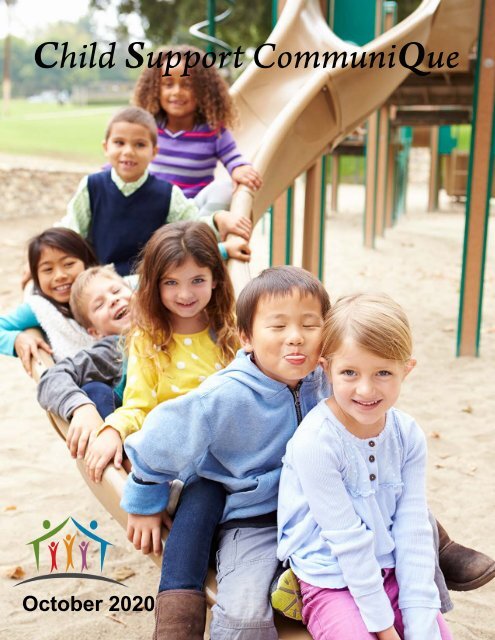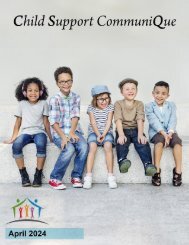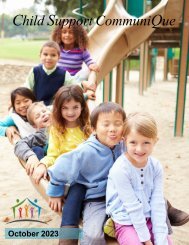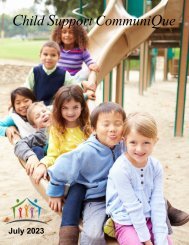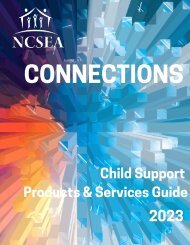Child Support CommuniQue - October 2020
You also want an ePaper? Increase the reach of your titles
YUMPU automatically turns print PDFs into web optimized ePapers that Google loves.
<strong>Child</strong><strong>Support</strong><strong>CommuniQue</strong>
Table of Contents<br />
<strong>October</strong> <strong>2020</strong><br />
President’s Message ………………………………………3<br />
Community Corner: Georgia <strong>Child</strong> <strong>Support</strong>, the Courts,<br />
and Private Income Deduction…………………………….5<br />
Taking Stock: Collections Base and Incentives …...……9<br />
IMM Encumbrances: The Elusive Pot of Gold…………14<br />
MOTIVATIONAL INTERVIEWING: Providing Great<br />
Customer Service Through Plexiglass………………….20<br />
Serving Your Team: How Managers Impact Work/Life<br />
Balance……….……………………………………………24<br />
NCSEA INSPIRE…………………………………………27
President’s Message <strong>October</strong> <strong>2020</strong><br />
by Lisa Skenandore, SMI<br />
Greetings! I hope this finds you all doing well. What<br />
a tremendous honor to serve as this year’s<br />
President. While we weren’t able to see each other<br />
in person at the annual Leadership Symposium and<br />
have the ceremonial passing of the gavel, I hope<br />
that you were able to watch the video. I am very<br />
humbled and honored to have received the gavel<br />
from Past President Tanguler Gray. She’s an<br />
outstanding leader, and I’m confident that she will be as instrumental in her<br />
next path as she has been to all of us. And I know you’re all wondering…is<br />
that gavel actually that big? Yes, it is. It also has quite a few nicks and<br />
gouges, and I’m not entirely sure where those came from.<br />
As the season of change is upon us for much of the country, I want to<br />
acknowledge all of the perseverance and hard work that child support<br />
professionals have undertaken. No one expected this year to be what it is,<br />
but so many have faced this time with ingenuity and dedication to the<br />
families we serve.<br />
Along with change in leadership comes change in committee work for<br />
NCSEA. I couldn’t thank our volunteers enough for the countless hours<br />
they give to the child support community. A few highlights for the next year<br />
include the Policy and Government Relations Committee led by Diane<br />
Potts. Under the committee’s guidance, we’ll continue to monitor and<br />
advocate for effective program policy. The year has already started out<br />
rather busy with new legislative proposals to review and address. We<br />
haven’t forgotten the legislative initiatives from last fall, and we will continue<br />
to advocate for those changes.<br />
I’m also very excited about this next year’s learning and development<br />
opportunities with both the Policy Forum and Leadership Symposium as<br />
well as our e-learning offerings. While it’s too early to venture a guess as to
what the state of the pandemic will be, please know that we are carefully<br />
monitoring our in-person events; everyone’s safety and wellbeing will be at<br />
the forefront of our decision making. That said, we have undertaken<br />
planning of the Policy Forum with this year’s theme of “Working Toward<br />
Equity Through Policy” with Shaneen Moore, Minnesota IV-D Director, and<br />
Erin Frisch, Michigan IV-D Director, leading us forward. We’ll take a hard<br />
look at program policy and the intersection of diversity, equity, and<br />
inclusion, and we’ll have thought-provoking conversations and discussions<br />
from leading policy experts to ensure the best outcomes for our families.<br />
We’ve also made a concerted effort to give members an opportunity to<br />
connect and share information utilizing NCSEA Connects. We have a very<br />
active intergovernmental group led by Rob Velcoff. As an outcome of the<br />
Idea Exchange topic of Diversity, Equity and Inclusion, we have created a<br />
new resource group. These groups provide a great opportunity to share<br />
resources and information across the child support community. If you would<br />
like to receive more information, please reach out to me or to NCSEA staff,<br />
Ann Marie Ruskin or Gillyn Croog.<br />
In closing, I look forward to the year ahead and thank you all for your<br />
continued service as we shape the future of child support together.<br />
_________________________________________<br />
Lisa Skenandore joined Systems and Methods Inc. as the Vice President of Business<br />
Development in January of 2016. Prior to joining SMI, Lisa led the Oneida Nation <strong>Child</strong><br />
<strong>Support</strong> Department as IV-D Director which became a comprehensive tribal child<br />
support program in April of 2008. She began her career in child support when her tribe<br />
received its start-up grant in 2005. Along with child support she has also led other<br />
human service programming in the areas of child welfare, domestic violence, prevention<br />
and foster care. She has served as President of the National Tribal <strong>Child</strong> <strong>Support</strong><br />
Association and National Association of Tribal <strong>Child</strong> <strong>Support</strong> Directors. Lisa currently<br />
serves as NCSEA President and is on the Board of Directors of the Eastern Regional<br />
Interstate <strong>Child</strong> support Association. She holds a Bachelor of Science degree in Public<br />
Administration from the University of Wisconsin at Green Bay.<br />
Print article here
Community Corner<br />
Partnership: Georgia <strong>Child</strong> <strong>Support</strong>, the Courts,<br />
and Private Income Deduction<br />
by Elaine Johnson, Georgia Judicial Council<br />
Administrative Office of the Courts<br />
Merriam Webster defines a legal partnership as an association of two or<br />
more persons or entities that conduct a business for profit as co-owners.<br />
In our world of child support, we do not make a profit in the traditional<br />
sense, but we all still profit through the services we offer the citizens of<br />
our states. Services conjures up many thoughts. Let’s explore what the<br />
GREAT state of Georgia has been doing since 2011 to benefit private or<br />
non-IV-D parents and private attorneys utilizing the Income Deduction<br />
Order (IDO) process to withhold and collect child support.<br />
We must begin by going back in time. Fortunately, we won’t need a<br />
DeLorean with a flux capacitor to go back to the year 2004 but join me as<br />
we make that journey. The Georgia Division of <strong>Child</strong> <strong>Support</strong> Services<br />
(DCSS) established the beginning of a long-standing relationship and<br />
contract between the Georgia Department of Human Services (DHS),<br />
DCSS and the Judicial Council, Administrative Office of the Courts<br />
(JC/AOC). Do you see what happened there? The executive and judicial<br />
branches of state government formed a partnership. Today, under the<br />
leadership of Georgia’s DHS/DCSS Director, Tanguler Gray, that<br />
partnership continues to thrive. Now, that’s a partnership!
Our partnership is called the <strong>Child</strong> <strong>Support</strong> Collaborative Project<br />
(Collaborative) and our primary job is to staff the Georgia <strong>Child</strong> <strong>Support</strong><br />
Commission and provide Georgia an Online <strong>Child</strong> <strong>Support</strong> Calculator for<br />
determining child support under the state’s guideline statute, O.C.G.A. §<br />
19-6-15. In addition to my position, the staff includes Noelle Lagueux-<br />
Alvarex, the Commission and Collaborative attorney, and Latoinna<br />
Lawrence, Program Coordinator.<br />
In May 2011, the federal Office of <strong>Child</strong> <strong>Support</strong> Enforcement released<br />
Action Transmittal 11-05, requiring states to use the Income Withholding<br />
Order for <strong>Support</strong> (IWO) form with paperwork submitted to employers. It<br />
was a good fit to add this task to the Collaborative’s list of things to do. In<br />
Georgia, attorneys and parents in private child support actions may petition<br />
the court for an IDO, separate from the divorce decree or other type of child<br />
support order. These Non-IV-D IDOs require payment of child support<br />
through the Family <strong>Support</strong> Registry (FSR), the state’s disbursement unit,<br />
in compliance with federal regulation 45 CFR 303.100(e)(1).<br />
With AT 11-05 in hand, my office quickly went to work with the DCSS<br />
Policy Unit, headed by Erica Thornton, to discover what should be done to<br />
achieve compliance. We put together a workgroup and key decisions were<br />
made focusing initially on:<br />
Reviewing Georgia law on Income Deduction Orders and determining<br />
how to incorporate the IWO into the Georgia IDO private/Non-IV-D<br />
legal process;<br />
Establishing a website to assist the courts, private attorneys, parents,<br />
and employers;<br />
Developing a referral process to the FSR to ensure correct<br />
documents were received to set-up a Non-IV-D case on the DCSS<br />
database for receipting and distributing payments;<br />
Developing a process for referring Non-IV-D IDOs to employers<br />
ensuring compliance with the federal IWO form and other forms<br />
required under Georgia law; and<br />
Developing a one-page IDO/IWO guide for judges, attorneys, and<br />
parents.<br />
Developing the IDO website was initially the most time-consuming task, but<br />
everyone in the workgroup contributed to the content and made it a<br />
success. Over the years, we have added, improved, and updated content
and resources. DCSS also established points of contact in its agency and<br />
at the FSR for my office to utilize for assistance. During the first year we<br />
addressed issues encountered with forms and processes and discovered<br />
the need for educating our judiciary, attorneys, parents, and employers. My<br />
office developed a one-hour training on the correct use of state forms and<br />
the required IWO. We included information on DCSS to ensure judges and<br />
lawyers were aware of the two types of cases, IV-D and Non-IV-D, and how<br />
they differ. We began the actual one-hour training in 2014 as a component<br />
of our routine child support guidelines and calculator training.<br />
While our Non-IV-D cases in Georgia have not dominated the marketplace,<br />
they certainly needed our attention. We have learned many lessons on how<br />
to best navigate and resolve issues encountered in those cases. The<br />
following graphic demonstrates a range of years and a comparison of the<br />
number of IV-D and Non-IV-D child support cases registered annually on<br />
the DCSS database i . The time period represented is May 2011 through<br />
July <strong>2020</strong>. The Non-IV-D cases represent 18% of the total cases registered<br />
during the nine years. This is a drop in the bucket compared to the number<br />
of IV-D cases registered during that same period.<br />
Georgia‐Comparing IV‐D to Non‐IV‐D<br />
Registered Cases by Year<br />
34948<br />
50901<br />
36800<br />
46911<br />
50877 52899<br />
49779<br />
38979 38905<br />
18153<br />
349 760 960 873 949 977 871 698 648 306<br />
2011 2012 2013 2014 2015 2016 2017 2018 2019 <strong>2020</strong><br />
Total IV‐D<br />
Total Non IV‐D<br />
Educating employers is always ongoing since they are a large group. We<br />
hear from employers and help them in understanding IDO process.<br />
Employers generally anticipate all IDO paperwork will come from the state’s<br />
IV-D agency, so we explain the Non-IV-D IDO process and how Georgia<br />
law differs on this point. When communicating with employers, we
ecognize the importance of acknowledging the contributions they make in<br />
withholding child support for Georgia parents and children. My office is<br />
always available and glad to assist employers in resolving issues and<br />
answering questions. Not all employers have legal departments and we<br />
have received comments that the IDO website is a helpful resource.<br />
States have their own procedures for handling income deduction and<br />
withholding processes for private Non-IV-D cases. While our processes are<br />
very functional in Georgia and have worked well for us over the past nine<br />
years, we realize our way may not fit exactly in your state. We hope this<br />
article inspires your state to consider a collaborative partnership for families<br />
and children in private Non-IV-D IDOs, or in some other area where<br />
bridging gaps in government will serve families and children in your state.<br />
Please contact me for a conversation on this topic. We welcome you to visit<br />
the Georgia <strong>Child</strong> <strong>Support</strong> Commission and Income Deduction Order<br />
websites: https://csc.georgiacourts.gov/, https://georgiacourts.gov/ido/.<br />
Elaine Johnson is employed by the Judicial Council, Administrative Office of the<br />
Courts ("AOC"), serving as the Executive Program Manager, a position created by an<br />
interagency contract between the Division of <strong>Child</strong> <strong>Support</strong> Services ("DCSS") and the<br />
JC/AOC. Elaine is a current member of NCSEA. Elaine came to the AOC in <strong>October</strong><br />
2007 and serves as staff to the <strong>Child</strong> <strong>Support</strong> Commission. She supports the online<br />
child support calculator in its design, maintenance, and training. Additionally, she<br />
serves as a liaison for the Courts with the Division of <strong>Child</strong> <strong>Support</strong> Services, and one<br />
of her tasks is working with the private Non-IV-D Income Deduction Order process.<br />
Previously, Elaine was employed for 30 years with the Division of <strong>Child</strong> <strong>Support</strong><br />
Services and during those years worked in management in two local offices, and finally<br />
in the state Policy Unit.<br />
Print article here<br />
i<br />
Graphic content provided by the Georgia Division of <strong>Child</strong> <strong>Support</strong> Services,<br />
https://childsupport.georgia.gov/.
Taking Stock: Collections Base and Incentives<br />
by Asaph Gloser, MEF Associates<br />
David Kilgore, California DCSS<br />
& Margot Bean, Deloitte Consulting, LLP<br />
If you walk into almost any local child support office around the country,<br />
staff can tell you how they are performing on the key measures used to<br />
calculate child support incentives. Since the passage of the <strong>Child</strong> <strong>Support</strong><br />
Performance and Incentive Act of 1998 (CSPIA) measures such as<br />
paternity establishment percentage, order establishment percentage, and<br />
collections on current support due have become some of the key<br />
barometers of success for individual staff, managers, and programs as a<br />
whole. Although these are not the only ways individual programs track their<br />
performance, they have remained a focus of child support programs for<br />
over two decades.<br />
Background on the Federal Performance Measures<br />
The emphasis on the core functions of the child support program as part of<br />
the incentive system was not accidental. The conversations among key<br />
child support stakeholders leading to the passage of CSPIA emphasized<br />
the importance of developing an incentive system that rewarded<br />
performance on measures that were most closely aligned with the core<br />
mission of the child support program – securing support for children and<br />
families. State performance on the federal performance measures has a<br />
substantial effect on the amount of incentive funding states receive. The
focus on the five performance measures (FPMs) has shown significant<br />
120<br />
100<br />
98<br />
94<br />
102<br />
2000<br />
88<br />
2019<br />
80<br />
72<br />
66<br />
62<br />
64<br />
59<br />
60<br />
54<br />
40<br />
120<br />
100<br />
80<br />
60<br />
40<br />
20<br />
0<br />
Statewide<br />
Paternity<br />
Establishment<br />
Percentage<br />
IV‐D Paternity<br />
Establishment<br />
Percentage<br />
<strong>Support</strong> Order<br />
Percentage<br />
Current <strong>Support</strong><br />
Percentage<br />
Payment on<br />
Arrears<br />
Percentage<br />
4<br />
5<br />
Cost Effectiveness<br />
Value<br />
20<br />
0<br />
Incentive Measures Performance Over Time<br />
improvement since 2000. 1<br />
Although the five CSPIA measures themselves are critical in calculating<br />
how much of the total incentive pool a state can receive, they are only one<br />
part of the calculation. States are vying for a share of a fixed incentive pool<br />
each year. No matter how well a state performs on the measures, the<br />
amount of incentive funds for which they are eligible is determined by the<br />
state’s collection base compared to the size of other states’ collections<br />
bases.<br />
The Collections Base Calculation<br />
A state’s collection base is the sum of all its collections in the previous<br />
year. Significantly, collections from current assistance, former assistance,<br />
and Medicaid cases are doubled in this calculation.<br />
The larger a state’s collections base, the more potential incentive funds that<br />
state is eligible for. By doubling collections from assistance and Medicaid<br />
cases, Congress sought to add an additional incentive for states to work<br />
1<br />
For more details on trends in state and national performance see: Benson, Valerie H. and Riley Webster<br />
(2018). The <strong>Child</strong> <strong>Support</strong> Performance and Incentive Act at 20: Examining Trends in State Performance.<br />
Washington, DC: Office of the Assistant Secretary for Planning and Evaluation, U.S. Department of<br />
Health and Human Services. https://childsupportresearch.org/files/The-<strong>Child</strong>-<strong>Support</strong>-Performance-and-<br />
Incentive-Act-at-20.pdf
the hardest to serve cases and to increase efforts to get child support to the<br />
families that need it most. 2<br />
The current calculation of states’ collection bases emphasizes the<br />
importance of collections on current and former assistance cases and<br />
Medicaid-only cases. This reflects both the origins of the child support<br />
program as a cost recovery mechanism for public assistance payments and<br />
a recognition of the added difficulty often associated with those cases. Put<br />
differently, the calculation of the collection base and the doubling for<br />
assistance cases is an incentive in and of itself. It is designed to incentivize<br />
child support programs to work the most difficult cases.<br />
Performance Observations<br />
What is now less clear is whether the incentive system put in place over 20<br />
years ago is still appropriately incentivizing states. Public policy changes in<br />
the years following welfare reform has resulted in a dramatic shift in public<br />
assistance caseloads. On average, the state TANF caseload in 1998 (the<br />
year CSPIA passed) was roughly 3.1 percent of each state’s population.<br />
Twenty years later, this percentage has gone down by 68 percent, with less<br />
than 0.7 percent of state residents on TANF. Moreover, this decline has not<br />
been uniform; across the states, the percentage of the population on TANF<br />
in 2018 ranged from 0.15 percent to 2 percent. As such, it is increasingly<br />
unclear whether the double counting of assistance and Medicaid case<br />
collections is having the intended effect on how states prioritize their<br />
caseloads.<br />
Doubling the collections base has real implications for incentive payments.<br />
Recalculating incentive payments using a collection base without the<br />
doubling would dramatically alter the landscape; 18 states would see an<br />
increase of at least 5% in their incentive payments, ranging from over<br />
$16,000 to over $5 million. Conversely, 19 states would see a decrease of<br />
at least 5% in their incentive payments, with dollar amounts ranging from<br />
2<br />
Gardiner, K. N., Fishman, M. E., Glosser, A., & Tapogna, J. (2004). Study of the implementation of the<br />
performance-based incentive system. Washington, DC: U.S. Department of Health and Human Services,<br />
Office of <strong>Child</strong> <strong>Support</strong> Enforcement.
over $70,000 to over $4 million. Removing the doubling affects both high<br />
and low performing states. Some high performing states gain and lose just<br />
as some lower performing states gain and loose if the doubling were<br />
removed. It is unclear how removing the doubling might benefit a given<br />
state based on its demographics or performance.<br />
Policy Considerations<br />
The current system reflects the values of the child support program –<br />
emphasizing the establishment of orders and the collection of support. The<br />
incentive measures themselves largely reflect the mission of the program<br />
and its core function.<br />
Is the doubling of TANF/Medicaid collections incentivizing referrals?<br />
Variation in TANF policy (e.g., benefit amounts, time limits) and Medicaid<br />
expansion has resulted in the overall referrals to the child support program<br />
declining in different ways from state to state. <strong>Child</strong> support programs<br />
continue to work cases referred regardless of the type of case they are<br />
despite that decline. That being said, the doubling is more likely to<br />
increase the collection bases of states with larger volumes of TANF and<br />
Medicaid cases. This may pull incentive funding away from those child<br />
support programs in states where assistance cases have declined.<br />
Are states with higher TANF/Medicaid cases benefiting because of a<br />
concerted focus on the part of the child support program? More than<br />
likely not. The child support program is heavily automated. State child<br />
support systems gather data, issue withholdings, intercept funds, and more<br />
to varying degrees. The systems themselves are blind to the case type<br />
treating all cases the same. Case workers intercede when customers<br />
struggle with the process or, as system technologies and analysis improve,<br />
when the system identifies that there are actionable tasks to take that will<br />
generate success. Although state and local child support programs can<br />
target current and former cases, there is rarely this explicit focus on such<br />
cases as a group.<br />
How would removing the doubling of TANF/Medicaid collections<br />
benefit the program? Aside from a general shakeup of the incentives<br />
across the states, there is little to be gained from removing this aspect of<br />
the calculation. Cost recovery is less of a cornerstone value of the national
child support program with the continued shift towards cost avoidance and<br />
the emphasis towards family self-sufficiency. Still, there is value in<br />
continuing to emphasize referrals and effort on TANF/Medicaid cases.<br />
These remain the most needy populations in our caseload and the current<br />
calculation is a policy decision that reflects the broader values of the child<br />
support program.<br />
____________________________<br />
Asaph Glosser, a Principal Associate in MEF Associates’ Seattle office, has substantial<br />
experience conducting research and evaluation projects for city, state, and federal<br />
agencies as well as non-profit partners. Asaph has authored numerous research reports<br />
and policy briefs and regularly presents his work to policymakers, practitioners, and<br />
others in the research community. When Asaph isn’t working, he spends as much time<br />
as possible either in his garden or exploring the beaches, mountains, and forests of the<br />
Pacific Northwest with his wife and two sons.<br />
David Kilgore is a proud graduate of the California State University at Northridge where<br />
he received his master’s degree in Public Administration and currently serves as<br />
Director for the California Department of <strong>Child</strong> <strong>Support</strong> Services. David has worked in<br />
the <strong>Child</strong> <strong>Support</strong> Program at the county level for 15 years and served as director of the<br />
Riverside County DCSS, chief deputy director and deputy director for Los Angeles<br />
CSSD, deputy director at the San Bernardino County DCSS and held several positions<br />
at the Tulare County DCSS including manager and staff services analyst. David served<br />
on the Board of Directors with the <strong>Child</strong> <strong>Support</strong> Directors Association and a member of<br />
the National <strong>Child</strong> <strong>Support</strong> Enforcement Association Board of Directors.<br />
Margot Bean is a Managing Director in Deloitte Consulting’s Public Sector Practice.<br />
Margot’s wide variety of government experience prior to joining Deloitte provides her<br />
with deep understanding and insight: Commissioner of the federal Office of <strong>Child</strong><br />
<strong>Support</strong> Enforcement, IV-D Director of the New York State <strong>Child</strong> <strong>Support</strong> program, IV-D<br />
Director of the Guam <strong>Child</strong> <strong>Support</strong> Program, and child support attorney. A Past<br />
President and Honorary Life Member of the National <strong>Child</strong> <strong>Support</strong> Enforcement<br />
Association (NCSEA), Margot is a member of the Current Board of Directors and cochairs<br />
the Corporate Relations Committee. She is a Past President and Honorary Board<br />
Member of the Eastern Regional Interstate <strong>Child</strong> <strong>Support</strong> Association (ERICSA). Margot<br />
also serves as an advisor to the Western Interstate <strong>Child</strong> <strong>Support</strong> Enforcement Council<br />
(WICSEC).<br />
Print article here
IIM ENCUMBRANCES:<br />
THE ELUSIVE POT OF GOLD<br />
by Bill Woods, Three Affiliated Tribes<br />
Division of <strong>Child</strong> <strong>Support</strong><br />
I come from Irish roots, and as a descendent from the “McBride” family of<br />
Ireland, I am most familiar with the storied rainbow myth— there's a pot<br />
of gold at the end of every rainbow guarded by a tricky leprechaun.<br />
This is a tale of my adventure to find a similar pot of gold at the end of a<br />
rainbow; and yes, I was met by tricky leprechauns along the way. This tale<br />
starts many years ago when I was attending a session focusing on child<br />
support collection efforts in Indian Country. The presenter was asked about<br />
trying to get monies from delinquent obligors through the Bureau of Indian<br />
Affairs (BIA). The response was that such efforts are not worth pursuing<br />
and the BIA is not required to deliver over to child support offices trust<br />
income from assets the federal government has in Individual Indian Monies<br />
(IIM) accounts.<br />
IIM accounts are accounts created by the Secretary of the Interior in each<br />
person’s name. The accounts receive income from trust assets and are<br />
held for the exclusive benefit of the individual Indian beneficiary.<br />
I decided that I was not going to take such assertion on face value but<br />
intended to do a little digging, and maybe I could dig up a pot of gold. When<br />
I arrived back at my office, I started to dig using the Code of Federal<br />
Regulations (CFR) as my shovel. Honestly, it didn’t take much digging to<br />
discover the provisions of 25 CFR Part 115 - Trust Funds for Tribes and<br />
Individual Indians, more specifically Subpart E. 25 CFR § 115.601, which<br />
sets forth the circumstances to restrict an IIM account through an<br />
encumbrance. The BIA may restrict an IIM account if the BIA receives an<br />
order from a court of competent jurisdiction awarding child support from an<br />
IIM account.
There I was, staring at the specific reference to child support that would<br />
lead me to various pots of gold, but I had forgotten that these pots of gold<br />
were guarded by a tricky leprechaun. In our case, we had to deal with the<br />
BIA and its reluctance to cooperate.<br />
Our office is located within the boundaries of the Fort Berthold Indian<br />
Reservation, and our reservation is home to the Three Affiliated Tribes –<br />
comprised of the Mandan, Hidatsa, and Arikara people. We had numerous<br />
tribal members who were not fulfilling their child support obligations. A<br />
portion of these tribal members has ownership rights in tracts of land, which<br />
are held in trust. These lands have production value for agricultural<br />
purposes, such as crop production or cattle grazing, and from mineral<br />
rights underneath the tracts. I needed to find out which of our obligors had<br />
such ownership interests.<br />
So, my thinking was I would<br />
So, my thinking was I would write a few write a few letters to the<br />
letters to the BIA, and it would let me BIA, and it would let me<br />
know if any of the tribal obligors had an know if any of the tribal<br />
active IIM account with funds being paid obligors had an active IIM<br />
into the account, then out into the pockets<br />
account with funds being<br />
of the obligor.<br />
paid into the account, then<br />
out into the pockets of the<br />
obligor. I initially submitted a list of over 200 obligors. I was met with a<br />
response that all IIM account information is confidential and privileged<br />
information, and the BIA would not comply with my request. So, I thought,<br />
ok, you little leprechaun, I will show you, and I filed my first Subpoena<br />
Duces Tecum to the BIA, demanding the BIA come to Tribal Court, and<br />
bring the records to establish IIM income from Trust assets. I also threw in<br />
a discovery request, just to add some stress and pressure to the BIA.<br />
That action got the leprechaun’s attention, in the form of a letter from the<br />
United States Department of the Interior, Office of the Solicitor, advising me<br />
that the Department does not allow its employees to testify or to produce<br />
Department records either upon request or by subpoena 43 C.F.R . § 2.81<br />
(b). I was informed that the Department may consider the request for
information if the same is requested thru 43 C.F.R Part 2, Subpart H and<br />
43 C.F.R. §§ 2.80(a)(4) and 2.83. These regulations are in accordance with<br />
the case of United States ex rel.<br />
Touhy v. Ragen, 340 U.S. 462<br />
(1951).<br />
This tricky leprechaun gave me a<br />
quest to fulfill to get the gold, as I<br />
needed to create a written request<br />
(Touhy Request) and submit the<br />
same. I followed the procedure to<br />
the letter, including setting forth<br />
that no testimony was sought,<br />
identifying the employee maintaining the records, describing the records<br />
sought, showing the records are not available from any other source,<br />
showing the records can be used in lieu of the employee’s testimony, and<br />
explained my compliance with section 2.88. Here you go, you tricky<br />
leprechaun, I thought, as I mailed off the Touhy Request in February, 2014<br />
to the local Office of Special Trustee, the Regional Fiduciary Trust<br />
Administrator, and the Attorney-Advisor with the Office of the Solicitor.<br />
Crickets, Crickets, Crickets. I heard nothing from any person at the<br />
Department of the Interior.<br />
Over the next few years, I broke a lot of shovels trying to dig up these pots<br />
of gold. I thought no way was this tricky leprechaun going to win. How can<br />
a department clearly ignore my request, and how could anyone in the<br />
Office of <strong>Child</strong> <strong>Support</strong> Enforcement (OCSE) or in elective office stand for<br />
it? I picked up another shovel, and sent letters out, even going to see if the<br />
local legal services office would litigate the matter on behalf of low-income<br />
parents who were not receiving child support or obtain a Writ of<br />
Mandamus. I wrote to both North Dakota senators and the Deputy Bureau<br />
Director in D.C. I challenged them to try and find that tricky leprechaun’s<br />
name and address. I complained to our Regional Program Manager, the<br />
Tribal <strong>Child</strong> <strong>Support</strong> Liaison and the Commissioner from 2016 and into<br />
2019.
They say the squeaky wheel gets the grease, backstory upon request, and<br />
I think I finally wore down some folks in Washington D.C., because I<br />
received calls and e-mails from the Office of the Solicitor – Division of<br />
Indian Affairs, in August 2019. I provided all the same documents, as I had<br />
back in 2014 and waited as (the tricky leprechaun) continued to process my<br />
request to honor the Touhy<br />
Request. Four months, I<br />
waited, again Crickets,<br />
Crickets, Crickets. I finally<br />
requested the name of the<br />
supervising attorney so<br />
that I could file a complaint,<br />
including asking what state<br />
bar association he/she was<br />
They say the squeaky wheel gets the<br />
grease, backstory upon request, and I<br />
think I finally wore down some folks in<br />
Washington D.C., because I received<br />
calls and e-mails from the Office of the<br />
Solicitor – Division of Indian Affairs, in<br />
August 2019.<br />
admitted to, intending to file an ethics complaint. I got an e-mail back that<br />
same day from the Assistant Solicitor, agreeing to look into the matter, and<br />
asking again for a copy of the February 5, 2014 letter from their office<br />
which initially instructed me to file a written Touhy Request. Guess what?<br />
We received the requested information and were staring at a pot of Gold.<br />
However, this fairy tale, did not end, just yet, happily ever after. Our office<br />
began the actual encumbrance processing of cases in the Fort Berthold<br />
Tribal Court – a Court of Competent Jurisdiction, which is a Court based<br />
upon Blacks Law: “One having power and authority of law at the time of<br />
acting to do the particular act.” We have subject matter jurisdiction and<br />
personal jurisdiction over the obligor, and quasi in rem over property within<br />
the geographical area, trust property within the reservation. We filed<br />
Motions, supported by Affidavits, sent out proper Notices for due process<br />
considerations, and presented the motions in court before a Tribal Judge.<br />
We obtained certified copies of Orders and delivered the Orders to the local<br />
BIA Superintendent. “Thank you – we will take our pot of gold in the form of<br />
a government check, please”.<br />
Not so fast, our tricky leprechaun had other thoughts. We received a copy<br />
of a Memorandum Letter that was distributed to all BIA Regional Directors,
the Director, Office of Tribal Services’ and Director, Office of Trust Funds<br />
Management from the Deputy Commissioner of Indian Affairs. The subject<br />
line of the letter dated November 9, 2001 was “<strong>Child</strong> <strong>Support</strong> Awards and<br />
Encumbering Individual Indian Money Accounts.” The Memorandum<br />
informed BIA officials nationwide that the “BIA will not honor back child<br />
support ordered claims against an IIM account.” Based upon the contents<br />
and directions of this memorandum letter, our office was informed that the<br />
local agency would not honor the certified copies sent to them. This<br />
leprechaun was proving to be a very tricky leprechaun, protecting the pot of<br />
Gold.<br />
The next step was to grab another shovel and keep digging, as I could not<br />
give up. Research was conducted, and I came across an Order from a<br />
Court that I did not even know existed. The Office of Hearings and Appeals,<br />
Interior Board of Indian Appeals, had issued a decision on <strong>October</strong> 31,<br />
2002, (tricky leprechauns must have been out trick or treating). The case, –<br />
Victoria J. Pretty Paint v. Rocky Mountain Regional Director, Bureau of<br />
Indian Affairs,33 IBIA 177 (2002), involved an appeal of a denial of back<br />
child support payments from an obligor’s IIM account. The denial cited the<br />
November 9, 2001 memorandum letter as support for the denial. The Court<br />
found nothing in 25 C.F.R. Part 115 that restricts the payment of back child<br />
support awards from the IIM account. The pot of gold was now again there<br />
for the taking.<br />
Hold up there a bit, if you want to go searching for this pot of gold on your<br />
own. I need to caution everyone looking into encumbering IIM accounts.<br />
There is an administrative procedure built into 25 C.F.R. Part 115, and<br />
each needs to be fully complied with. It starts with verifying your court is a<br />
court of competent jurisdiction. The BIA may not recognize a state court<br />
order to encumber. Best advice is to get the Order from the Tribal Court<br />
where the trust assets are located. Second consideration, you will need to<br />
school or teach your local BIA office of the procedures and the law, as the<br />
aforementioned 2001 memorandum letter seems to re-surface from time to<br />
time. The next constant consideration is need for patience; as your office<br />
will need to rely on the BIA to follow the Part 115 requirements, including
notice, and ability to challenge the decision to restrict, based upon undue<br />
hardship. All BIA hearings are conducted without notice or appearance by<br />
child support but are recorded and obligors can have an attorney to<br />
represent them. We have a procedure in place, and there is an approved<br />
form for an obligor to fill out to consent to the sums to be taken from their<br />
accounts. Obligors who have encumbrances put in place, and no funds are<br />
payable to them for several months may choose to turn over funds to child<br />
support, so the remainder can be released from the IIM account to them.<br />
It has been a long journey, I learned a lot, lost some to the tricky<br />
leprechaun, and won some in the long run. We have gotten some pots of<br />
gold – payable in U.S. treasury checks. However, we have not received<br />
some pots of gold that we are still waiting on. By the way, as to our last<br />
Touhy Request…Crickets, Crickets, Crickets.<br />
“go raibh maith agat” – (thank-you).<br />
______________________________<br />
William E. Woods Jr. (Bill) is an attorney presently working with the Three Affiliated<br />
Tribes (TAT) Division of <strong>Child</strong> <strong>Support</strong> in New Town, North Dakota in the positions of<br />
Staff Attorney. Bill has been working with TAT child support for about 12 years. Bill is<br />
currently a member of the Board of Directors for the National Tribal <strong>Child</strong> <strong>Support</strong><br />
Association. Prior to current employment with TAT, Bill previously ran a satellite child<br />
support office on the Fort Berthold Reservation working tribal child support cases for<br />
four (4) North Dakota Regional Offices. Bill received his Bachelor of Science degree in<br />
Criminal Justice from Minot State College in North Dakota in 1981, then a Juris<br />
Doctorate degree from the University of North Dakota (1984). In addition to duties with<br />
TAT child support, Bill holds positions with the Mountrail County Asst. States Attorney;<br />
City Attorney for Parshall, North Dakota; City Attorney for New Town, North Dakota; City<br />
Attorney for Plaza, North Dakota; Mountrail County Housing Board; and member of the<br />
MHA Nation Supreme Court.<br />
Print article here
MOTIVATIONAL INTERVIEWING:<br />
Providing Great Customer Service Through Plexiglass<br />
by Jill Keister, Natrona County (WY) <strong>Child</strong> <strong>Support</strong><br />
<strong>Child</strong> support customers are experiencing added barriers to receiving<br />
services right now. Some offices are closed to the public entirely, while in<br />
some open offices, in-person interactions are done through plexiglass<br />
dividers. Motivational Interviewing (MI) is a way to overcome these barriers<br />
and build partnerships in a way that is compassionate, empathetic, and<br />
accepting.<br />
What is Motivational Interviewing?<br />
MI is a collaborative conversation to strengthen a person’s own motivation<br />
for commitment to change. The Wyoming <strong>Child</strong> <strong>Support</strong> Program began<br />
using MI in its customer service communications four years ago. The<br />
Wyoming team members knew their customer service was excellent, but<br />
they wanted to make conversations with their customers more meaningful.<br />
That’s when they made the decision to begin using MI.<br />
MI is used when a customer is ambivalent about a change he or she is<br />
trying to make. There is a spirit in motivational interviewing that is kept at<br />
the forefront of all interactions team members have with customers. That<br />
spirit is explained by the acronym PACE. <strong>Child</strong> support professionals<br />
partner with the customer and come to the table as an equal; no one is an<br />
expert over another person’s life or situation. They accept and work with<br />
the customer right where the customer is, expecting nothing more.
Customers come in with a wide variety of emotions and child support<br />
professionals have found that the ability to show compassion helps to build<br />
trust. Professionals use evocation to allow customers to build a plan with<br />
their own ideas of how they see their child support case going forward,<br />
which helps set the case up for success. When customers are allowed to<br />
have their own thoughts rather than a child support professional telling<br />
them what to do, ownership begins to take place.<br />
A MI conversation ends with the customer designing a plan of action. The<br />
child support professionals then commit to following up with the customer<br />
and providing any additional support.<br />
What skills do you need?<br />
MI has four specific skills. The acronym OARS defines those skills:<br />
Open-ended questions are used to gather and gain information from<br />
customers. These questions open up the conversation more than closedended<br />
questions, which tend to elicit yes or no answers and can make<br />
customers feel interrogated.<br />
Affirmations point out customers’ strengths.<br />
Reflective listening is an important part of the skill set that helps customers<br />
know that they are heard and understood.<br />
Summaries are used to pull main themes and thoughts together and can<br />
help make connections with customers.<br />
How do you implement MI?<br />
As with any new initiative, training is the first thing on the agenda. Wyoming<br />
contracted with a Motivational Interviewing Network Trainer (MINT) for a<br />
two-day training program for its initial group, which included the IV-D<br />
director, attorneys, and case specialists. Part of the initial training includes<br />
setting up a regular practice schedule. The MINT trainer suggested that this<br />
group practice together once a week for 6 months. After that time, the<br />
trained team members met for one hour each month. Each office around<br />
the state participated in these sessions over Google Hangouts. The<br />
sessions were used to practice the spirit and skill set along with introducing
other elements, such as the four processes, resisting, and agenda<br />
mapping.<br />
This structure ran for two years. It was from these sessions that strong<br />
members of the team emerged. These child support professionals then<br />
formed a train-the-trainers group. The train-the-trainers group met with the<br />
MINT trainer for a two-day workshop in 2018 and created a MI training<br />
manual that can be updated when necessary.<br />
Trainers must meet specific criteria:<br />
● A strong passion for helping others have meaningful conversations<br />
using MI<br />
● Participation in the two-day basic training<br />
● At least one year of child support experience<br />
● Attend an advanced training session<br />
● Achieve proficiency with the skills<br />
Each potential trainer recorded a 20-minute tape and sent it to the MINT<br />
trainer. The MINT trainer coded each tape looking for all elements of the<br />
spirit, open-ended questions, affirmations, reflections, and summaries in<br />
the conversation. This may sound like an easy task; however, some<br />
potential trainers did not pass on the first submission. It took several tries to<br />
gain proficiency. The goal was to have top notch trainers very skilled in<br />
motivational interviewing so they could train and teach others in the<br />
program.<br />
This group currently meets once a month and creates the monthly session<br />
for each office to use for practicing the skill set. The ultimate goal is to have<br />
a representative from every office in the program join this group. The group<br />
most recently added champions from offices where they do not have a<br />
trainer. Champions are child support professionals who have a strong<br />
passion for MI but are not yet proficient in it. After six months, a champion<br />
who wishes to become a trainer works on submitting a tape to be coded.
The trainers’ group has been fortunate to meet with the MINT trainer<br />
annually, which allows the group to explore any challenges in training and<br />
to gain the newest MI information.<br />
The trainers’ group is composed of all levels of child support professionals<br />
from case specialists to supervisors along with members of the State<br />
Disbursement Unit and The State Office.<br />
How do new team members get trained in MI?<br />
The training group puts on an annual two-day basic motivational<br />
interviewing training. The trainees walk away with the basic understanding<br />
and use of motivational interviewing, the spirit and the OARS.<br />
Does the Wyoming <strong>Child</strong> <strong>Support</strong> Program track the data?<br />
For evaluation purposes, the group decided to track:<br />
● Each interaction<br />
● The customer’s next action after the MI conversation<br />
● The team member’s success<br />
● The customer’s success<br />
A special screen was created in the child support computer system. Team<br />
members use this screen to report the outcome of each MI conversation.<br />
Team members then rate both their part and the part of the customer. The<br />
outcome of the interaction can range from making a payment, providing<br />
necessary documentation, setting up a follow up appointment, completing a<br />
step in a plan, or following up to give a progress update. When customers<br />
take ownership, they are responsible to complete their own plan. A monthly<br />
report is sent out providing this information. It is clear from the feedback<br />
given from team members that successful results do not equate to money;<br />
more importantly, success equates to making meaningful connections with<br />
customers.
What is the future of MI?<br />
MI has played a significant role in providing excellent customer service<br />
during the pandemic. It has been extremely useful to have the spirit of<br />
motivational interviewing available in today’s environment when<br />
communication can be restricted. At the outset of the pandemic, the lobbies<br />
of most offices were closed to the public. The call volume increased. MI is<br />
equally effective over the phone and can also be done in writing.<br />
The MI curriculum, training and monthly practice sessions are going strong.<br />
Wyoming made a few changes in response to the pandemic. The training is<br />
now done virtually. The MINT trainer helped create the online training in a<br />
short window of time. In August <strong>2020</strong>, Wyoming trained 17 new team<br />
members using Google Hangouts and Google Classroom.<br />
The Wyoming <strong>Child</strong> <strong>Support</strong> Program is working on the areas of domestic<br />
violence and employment services. The MI skill set will be a helpful tool in<br />
these areas. The continued practice of all team members throughout the<br />
program helps MI become second nature when working with customers<br />
who are experiencing ambivalence. The Wyoming <strong>Child</strong> <strong>Support</strong> Program<br />
is looking forward to new uses of the skill set to make strong connections<br />
with their customers. Using partnering, acceptance, compassion and<br />
evocation reminds us all that, working together, people can feel heard and<br />
know that they are part of their own success even when we are talking<br />
through a plexiglass barrier.<br />
_________________________________________<br />
Jill Keister has been working for Natrona County <strong>Child</strong> <strong>Support</strong> Department for the past<br />
30 years. She has an Associate of Arts degree in Human Communication. Jill currently<br />
serves as the Department Head for Natrona County <strong>Child</strong> <strong>Support</strong> Department. She is a<br />
member of the Wyoming <strong>Child</strong> <strong>Support</strong> Association and is a past president. Jill serves<br />
on many statewide child support committees.<br />
Print article here
Serving Your Team:<br />
How Managers Impact Work/Life Balance<br />
by Kimberly Newsom Bridges, Conduent<br />
Editor’s Note: This is the final article and podcast in the NCSEA Work/Life<br />
Balance Series. When we pitched this idea in late 2019, we had no idea<br />
how critical work/life balance would become in <strong>2020</strong>. As the series ends,<br />
we hope that these articles and podcasts have given you something to<br />
think about, helped you understand you aren’t alone, and has been a<br />
conversation starter for you and those who support you in your professional<br />
and personal life.<br />
I have had the opportunity to lead teams of people throughout my career.<br />
Recent studies clearly show that people stay or leave a company because<br />
of its leaders. As a leader, I have learned many things through trial and<br />
error. The things that have stuck with me are those that truly impact my<br />
relationship with my team members and the wins we have working together<br />
as a team. As an employer, I have learned four main things that I believe<br />
directly impact those relationships and wins. First, you have to know your<br />
team members. Second, you have to remember what they tell you. Third,<br />
you have to take the time to work with them to right the ship when things go<br />
awry. Finally, be transparent.<br />
Knowing your team members goes beyond knowing their names. As a<br />
leader, it is imperative that you learn about their families, what they like to<br />
do, and what their aspirations are for their careers. This means that you<br />
have to take the time to have real conversations with your team. At one<br />
point early in my career, I had a team of 80+ people. I took each one to<br />
lunch at least once a year. I truly enjoyed these “investigative” lunches.<br />
They provided an opportunity to share information about both of us. These<br />
lunches made me human to them and provided me an opportunity to learn<br />
more about my team. Having these relationships helps when difficult<br />
conversations need to take place. It also helps your team members feel<br />
more comfortable sharing issues they are facing that may be impacting
their productivity. One word of advice: don’t wait until there is a problem to<br />
try to develop a relationship.<br />
When you take the time to get to know your team members, it is critically<br />
important that you remember the conversations. Otherwise, your team will<br />
believe your efforts were superficial. Remember something that you were<br />
told, like their career aspirations, maybe an<br />
issue with their children and/or the health<br />
of a friend or parent. Follow up with them.<br />
Challenge them to do things that will help<br />
them achieve their career goals. Ask them<br />
about their parent’s health. Don’t just do it<br />
in passing. Ask the questions when you<br />
have the time to really pay attention to their<br />
response. Challenge them career-wise<br />
when you have the time to mentor them.<br />
Help with their fears and give them<br />
constructive feedback.<br />
Finally, always be willing to have difficult<br />
conversations with your team members. If they aren’t meeting<br />
expectations, make sure you are willing to coach them to success.<br />
Sometimes, the performance issue is related to things occurring outside of<br />
the workplace. Be prepared to listen and offer insight. As an employer,<br />
hopefully you have an Employee Assistance Program where you can refer<br />
team members. Sometimes, they might need someone to listen. Balancing<br />
an understanding of their personal issues with the fact that the work still<br />
needs to be completed is an art. If you master it, your team members will<br />
follow your lead and you will have a high performing team.<br />
Being transparent is all about communication. As a leader, be willing to let<br />
others know you have a life. If you are taking the day off to watch your kids<br />
in an activity, let people know that is why you are taking the day off. If you<br />
are working late, share that it is because you decided to do that and ensure<br />
that your team knows you don’t expect them to be watching for<br />
communications from you 24/7. Your team will appreciate that you are<br />
human and the fact that you are establishing expectations for their work<br />
life.<br />
As we finish this series, I have one final comment regarding work/life<br />
balance. If we are striving for a 50/50 balance every day, we will be<br />
disappointed. In our ever-changing lives, we have to figure out how to be<br />
flexible enough to realize that a true daily 50/50 balance is not realistic.<br />
While listening to a podcast recently, I remembered the following statement
around work/life balance: Work Life Balance is not about 50/50 split in time;<br />
rather, it is about being 100% present wherever you are at the time. That is<br />
my challenge to all of us. Be present. Don’t feel guilty about where you<br />
aren’t. Be happy about where you are.<br />
_________________________________________<br />
Kim Newsom Bridges has been a child support professional for over 25 years. She<br />
joined the Conduent <strong>Child</strong> <strong>Support</strong> Services team in 2016, where her efforts are<br />
focused on innovation in the child support program and assisting the IV-D Community in<br />
the identification, implementation and improvement of child support systems and<br />
services nationally. Prior to joining Conduent, she served as the Executive Director for<br />
the Ohio CSEA Directors’ Association (OCDA). Kim has also served NCSEA in many<br />
capacities, including President and chair of several committees. Kim received a<br />
Bachelor of Science in Business Information Systems and a Juris Doctor from Ohio<br />
State University.<br />
Print article here
NCSEA’S <strong>2020</strong> “INSPIRE”<br />
by Ashley Dexter, Deloitte Consulting LLP<br />
and Phyllis Nance, Alameda County DCSS<br />
Co-Chairs, NCSEA INSPIRE<br />
NCSEA’s annual Leadership Symposium has been a flagship event for<br />
child support professionals for years. Year after year, participants could<br />
count on a gathering of emerging and recognized leaders from around the<br />
country, sharing their ideas and inspiration. The COVID-19 pandemic<br />
brought things to a screeching halt in the springtime, just as preparations<br />
were being finalized. Would there even be a Leadership<br />
Symposium? Should there be one? How could it even be pulled off, with<br />
quarantines and lockdowns in place everywhere and indefinitely? We at<br />
NCSEA answered the first questions with a definite “YES”. In times of<br />
uncertainty, where the present is constantly shifting and the future is almost<br />
unimaginable, leadership and the ability to inspire change are critical to the<br />
success of organizations. When we are all physically separated, the need<br />
to connect, to learn from and help each other is harder to do and even<br />
more important. The Leadership Symposium would be an ideal forum for<br />
meeting this need. With the goal set, it was just a matter of figuring out how<br />
to deliver this in our new and evolving “normal.”<br />
On Tuesday, <strong>October</strong> 6 th , <strong>2020</strong>, NCSEA launched INSPIRE, a virtual<br />
engagement event, to bring child support professionals from around the<br />
world together to network, educate, and discuss new and invigorating ideas<br />
and approaches to leadership and daily work. The event spans four weeks<br />
in <strong>October</strong> allowing flexibility for individuals to choose sessions that work<br />
with their schedules. Utilizing a new platform Remo, INSPIRE offers<br />
plenaries, workshops, learning labs, NCSEA Book Club, and a <strong>Child</strong>
<strong>Support</strong> Hackathon using various presentation styles and topics to choose<br />
from and attend, and it’s all FREE to NCSEA members.<br />
INSPIRE kicked off with Marny Lifshen<br />
providing invaluable interpersonal skills<br />
and real-world, hands-on strategies to<br />
developing professional relationships in<br />
light of our new “normal” virtual working<br />
environment. In the sessions that<br />
followed, NCSEA U facilitators Kim<br />
Newsom-Bridges and Charles Smith<br />
continued the conversation about<br />
communication and the importance of<br />
relaying information so others receive the<br />
message correctly as well as effectively<br />
listening to what others share. Orange County, CA <strong>Child</strong> <strong>Support</strong> Services<br />
Director, Steven Eldred, and Ramsey County, MN District Attorney and<br />
Director, Dr. Trish Skophammer provided thought-provoking research and<br />
insight into the child support – child welfare connection that has perplexed<br />
both programs for years. The Book Club closed out the first week of<br />
INSPIRE with a discussion on “The Ideal Team Player” by Patrick Lencioni<br />
that discusses practical leadership and management styles to help develop<br />
employees and evaluation tools for current and potential future employees.<br />
Upcoming weeks offer sessions focused on diversity and inclusion, data<br />
and systems, child support programmatic content, and leadership and<br />
professionalism. Two active Learning Labs provide real time interaction for<br />
session participants with each other and the presenters. During the closing<br />
plenary, a panel of national experts will look to the future for ways<br />
government agencies can provide the most effective and beneficial<br />
services to families in light of lessons learned from the pandemic that<br />
defined <strong>2020</strong>.<br />
Finally, INSPIRE closes on Thursday, <strong>October</strong> 29 th with a <strong>Child</strong> <strong>Support</strong><br />
Hackathon. Submissions were received from 11 unique agencies from<br />
across the country resulting in 16 challenges and corresponding solutions<br />
child support agencies have faced and overcome with innovating ideas.<br />
Four agencies were selected and will showcase their “Hacks” to compete
for the Judge’s award as well as the People’s Choice Aware voted on by<br />
YOU, the live audience!<br />
Although the <strong>2020</strong> Leadership Symposium Planning Committee wished we<br />
could have spent this year’s event with you in Anaheim back in August, we<br />
are thrilled that so many of you chose to join us virtually for INSPIRE.<br />
Almost 850 of you registered resulting in over 5200 hours of professional<br />
development! We have had great reviews about the Remo platform and the<br />
ability for child support professionals to interact and spend time with each<br />
other. On behalf of the INSPIRE Planning Committee, thank you for joining<br />
us at INSPIRE. We hope you are enjoying the opportunity to network with<br />
friends and colleagues, as well as make new connections from around the<br />
world from wherever you may be working.<br />
Thank you to the <strong>2020</strong> Leadership Symposium Planning Committee for all<br />
their hard work planning and preparing for Anaheim as well as the <strong>2020</strong><br />
INSPIRE Planning Committee that developed and crafted engaging content<br />
for this year’s virtual event. Finally, a special thank you to Gillyn Croog and<br />
Ann Marie Ruskin for their forward thinking and innovative ideas to bring<br />
INSPIRE to fruition utilizing an amazing collaborative new platform<br />
enhancing our ability to network and learn virtually.<br />
We look forward to seeing all of you next year in Austin, TX August 1-4,<br />
2021!<br />
Ashley Dexter is a Specialist Senior with Deloitte Consulting LLP. Prior to joining<br />
Deloitte, Ashley began her career over 18 years ago in the Kansas child support<br />
program and served most recently as the Kansas Deputy IV-D Director. Ashley is a<br />
member of NCSEA’s Board of Directors since 2018 and served as the co-chair of the<br />
2019 and <strong>2020</strong> Leadership Symposium and the <strong>2020</strong> INSPIRE Virtual Event. She has<br />
spoken at several Leadership Symposiums and at other national events, including<br />
annual conferences for WICSEC and ERICSA.<br />
Phyllis Nance is the Director for the Alameda County, CA Department of <strong>Child</strong> <strong>Support</strong><br />
Services. Phyllis has worked in child support for nearly 33 years. She served as the<br />
Director for Kern County Department of <strong>Child</strong> <strong>Support</strong> from 2008-2015. In 2016 she<br />
was appointed Director in Alameda County. Phyllis served as the co-chair of the <strong>2020</strong><br />
Leadership Symposium and the <strong>2020</strong> INSPIRE Virtual Event. She is the immediate Past<br />
President of the California <strong>Child</strong> <strong>Support</strong> Directors Association (CSDA) and has spoken<br />
at several state conferences as well as national conferences including Leadership<br />
Symposiums.<br />
Print article here


